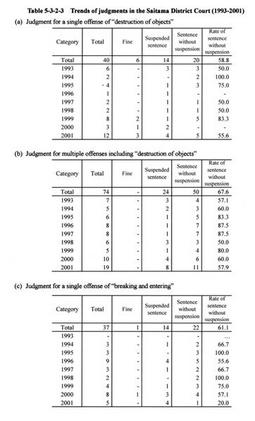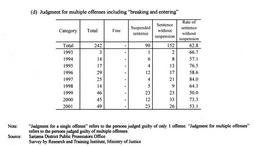| Previous Next Index Image Index Year Selection | |
|
|
2 Research results for destruction of objects and breaking and entering (1) Outline of sample research Destruction of objects and breaking and entering are offenses for which the statutory penalties originally are not heavy, and most offenders who committed these offenses are not prosecuted or are merely fined under a summary order. Since an enormous number of these 2 offenses are committed, it is practically difficult to conduct not only research on every single offense but also nationwide research. Therefore, in order to gain an understanding of the concrete nature of these offenses and circumstances for which imprisonment terms may vary, the Research and Training Institute of the Ministry of Justice researched all judgments delivered by the Saitama District Court (former Urawa District Court) in the 9 years from 1993 to 2001, based on the data provided by the Saitama District Public Prosecutors Office.
The Saitama District Court was selected as the subject of this research because the court, whose jurisdiction was extended to cities, rural villages, moderately-sized industrial regions, and what were known as "bed towns" (commuter suburbs); furthermore, the number of persons disposed by this court was somewhere between 1,500 and 2,000 annually. In light of these facts, the Saitama District Court was considered to be suitable for this research on the grounds that the statistical and regional discrepancies. seemed to be relatively few. (2) Trends in the number of persons judged by courts Table 5-3-2-3 shows research results for 393 persons for which the outline and circumstance of offenses were clear (114 persons sentenced for destruction of objects, and 279 persons sentenced for breaking and entering), out of the total persons judged by the court during the years 1993 to 2001. In order to analyze the actual status of the 2 offenses and the characteristics of offenders, this search targeted not only the persons judged for either destruction of objects or breaking and entering, but also persons who were charged with multiple offenses including destruction of objects and breaking and entering. Additionally, persons who concurrently or consecutively committed 2 offenses and received a single judgment were calculated in duplication.
As for destruction of objects, in 2001, the number of persons judged by the court noticeably increased from the previous year. On the other hand, with respect to breaking and entering, the number of persons judged has stayed within the range of 50 or over but below 60 since 1999. Table 5-3-2-3 Trends of judgments in the Saitama District Court (1993-2001) (3) Trends in the method and nature of destruction of objects Considering the facts constituting a crime and the facts determining imprisonment terms by the court, the style and nature of destruction of objects for which formal trials were requested can be categorized as follows: (a) the destruction of expensive property, such as cars, custom gates, and hospital computers; (b) offenses of a dangerous nature, such as property arson, throwing concrete blocks into buildings, etc., and destruction of elevator safety devices; (c) offenses committed in a series over a short period of time, or committed by habitual offenders over a long-term; (d) offenses resulting from stalking or domestic violence, offenses that were committed for the purpose of harassment due to troubles with neighbors, and offenses for which the motivation and purpose are of dangerous or evil nature, such as what is termed orei mairi (offense committed by organized crime group members for the purpose of revenge after the victim files a suit against them)", and (e) offenses committed by offenders with previous convictions for an offense of the same kind or by those with multiple previous convictions for violent offenses, and offense committed by repeat offenders under suspended sentence, etc.
As stated above, there are a wide variety of offenses related to destruction of objects, including grand offenses, some of which might cause damages to expensive property or the spread of fire resulting in death of bodily injury. Therefore, destruction of objects should not be automatically treated as a minor offense. (4) Trends in the style and nature of breaking and entering Breaking and entering can be characterized as follows: (a) the number of persons who committed breaking and entering for the main purpose of larceny was the highest, accounting for 201 persons out of 279 persons who committed breaking and entering. However, we could also recognized offenses such as (b) offenses for the purpose of homicide, robbery, rape, indecent assault, extortion, capture, confinement, and abduction, etc., (c) habitual offenses, or consecutive offenses over a short period of time, (d) planned offenses with the use of knives, handcuffs, and special lock-picking tools for the purpose of robbery, assault, intimidation and rape, and (e) offenses committed by offenders with multiple previous convictions for larceny, etc., or by repeat offenders under suspended sentence for larceny or indecent assault.
In particular, among cases in which other offenses were committed immediately after breaking and entering houses, there are many cases where offenders committed the offenses that were their real purpose, such as homicide, robbery, rape, indecent assault, larceny, and bodily injury, after breaking and entering houses. Moreover, there are some cases where offenders committed robbery by using the threat of violence when detected, rape, and homicide, on the ground that they encountered victims in the houses they had broken into and entered. This trend suggests that breaking and entering is often committed for the purpose of robbery, larceny, and rape, etc., and is highly likely to develop into a dangerous offense that might cause real damage to victims. |

